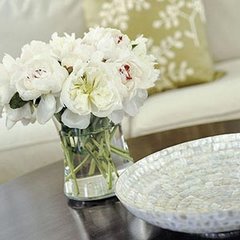
Could your life use a bit of softness? Here are some tips to strip stress from your rooms and your life.
Soften the Edges
Much of life is harsh and demanding, so cut the hard corners off your decor to give it a relaxing look and feel. Textiles are your main ally in this quest. Drapes that pool on the floor, loose-fitting slipcovers, and tons of pillows all bring a sense of ease to a space.
Redo a Room with Simple Changes
The easiest way to freshen a room is to change a room's looks with the seasons. Adding elements of the season make a room more welcoming. Seasonal elements like plants, flowers, and other decorations can give a room an instant facelift.
Move the Outdoors In
The goal of garden style is to blur the line between indoors and out, but without sacrificing all the comforts of modern domesticated spaces.
Soak Away Stress
Wash away the cares of the day. Install a tub deep enough to soak in, add thick towels, warm colors, soft lighting, and soothing music to make those precious moments an experience that bathes body and soul, refreshing both.
Dream Up a Relaxing Bedroom
The calming influence of a bedroom beyond the bed: Keep only the essentials within reach and within view. Decorate the walls in the colors that comfort you, and add only artwork that makes you smile. Cover the floor with rugs or carpeting that feels best on bare feet. Cocooning your bed in yards of fabric can also help you block out the world, literally and figuratively.
Organize Away Chaos
Chaos breeds anxiety, so think of the time spent getting organized as prep time for calm to come. If your life is teeming with stuff, start the path to organization by focusing on a single space.
Create a Comfort Zone
Make a place in your home where relaxing is the key function. Make it convenient for your choice of relaxing activity -- reading, listening to music, or watching a movie.
Make a Place to Plan
Have everything you need close at hand so you can concentrate on the work you need or choose to do. Make it an inviting place by adding personal elements and comfort.
Dress an Inviting Table
To make a table inviting by add things like: flowers, candles, linens, etc. China of a lively pattern or rich color becomes its own statement, requiring little accompaniment to set a style.
Make Mornings Sing
A place to enjoy a few moments at the beginning of the day goes a long way toward keeping you relaxed. Even if you don't have a breakfast nook or the time to enjoy it, set up a portion of the kitchen strictly for the functions of morning. Having the coffeemaker, toaster, and cereals all gathered in one area helps to create focus.












